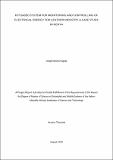IoT based system for monitoring and controlling of electrical energy for leather industry a case study in Kenya
Abstract
Nowadays, most industries receive large energy consumption sheets daily, making it
challenging to monitor and control energy consumption. This suggests a need for the
development of an energy monitoring system to help observe the energy consumption behavior
and be able to make timely corrections in energy consumption. Therefore, this project aimed
to develop the electronic prototype of the monitoring and control system from an application
for a cell phone with an Android system. The energy monitoring system could help in saving
precious non-renewable sources. This project employed the agile methodology to allow for
system requirements and analysis, system development, system implementation, integration,
and testing. The information was acquired using energy consumption sensors and analyzed
based on statistical tables stored in the cloud, for four days. The sensors communicate via a
wireless network that operates on the 2.4GHz frequency, where the NRF 24 L01 + transceiver
was used. Moreover, a Raspberry pi Zero was utilized for the configuration of the central node,
and this was responsible for the collection of the information gathered in the sensors and
publishing it in the cloud every hour. For the android system-based application, the data was
collected graphically. Lastly, the developed system also produces real-time consumption data,
which were then analyzed to identify the devices with the highest consumption level relative
to the total number of devices. The information gained after the analysis of the data was also
useful in identifying any damaged equipment or machine. The damaged equipment and
machine portrayed different behaviors (they appear to be outliers) in their energy consumption
when compared to undamaged ones.

